Sega
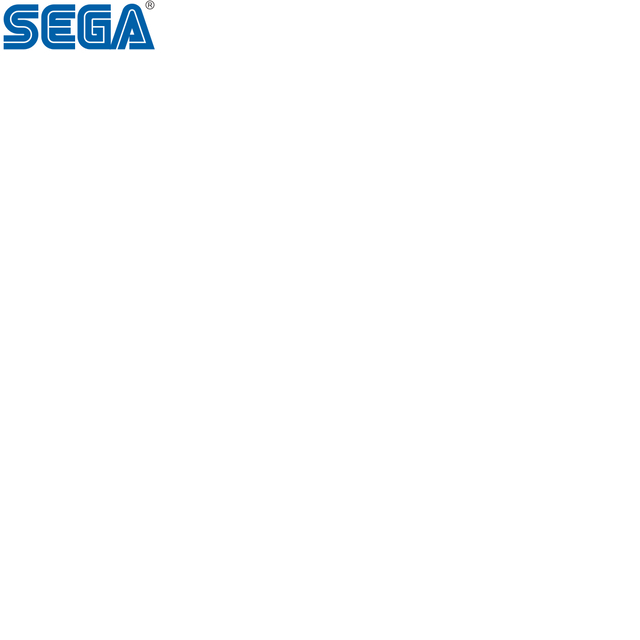
Sega

| Kabushiki gaishaSega Gēmusu | |
| Subsidiary | |
| Industry | Video games |
| Predecessor | Service Games of Japan |
| Founded | June 3, 1960 |
| Founders | |
| Headquarters | Sumitomo Fudosan Osaki Garden Tower,, |
| Worldwide | |
| Products | |
| Revenue | 208 billion (2018) |
| 14.8 billion (2018) | |
| Owner | Sega Sammy Holdings |
| 5,349 | |
| Parent | Sega Holdings Co., Ltd. [[News Corporation]] |
| Divisions | Sega development studios |
| Subsidiaries | |
| Website | |
| Footnotes / references | |
Sega Games Co., Ltd. [1]SAY-gə SEGA[2]multinational developer okyo. Its international branches, Sega of America and Sega Europe, are respectively headquartered in Irvine, California and London. Sega's arcade division, once part of Sega Corporation, has existed as Sega Interactive Co., Ltd. since 2015. Both companies are subsidiaries of Sega Holdings Co., Ltd., which is in turn a part of Sega Sammy Holdings.
Sega was founded by Martin Bromley and Richard Stewart as Nihon Goraku Bussan[3] coin-operated games]]. Sega developed its first coin-operated game with 969, Sega was sold to Gulf and Western Industries. Following a downturn in the arcade business in the early 1980s, Sega began to develop video game consoles, starting with the SG-1000 and Master System, but struggled against competitors such as the Nintendo Entertainment System. In 1984, Sega executives David Rosen and Hayao Nakayama led a management buyout of the company with backing from CSK Corporation.
Sega released its next console, the Sega Genesis (known as the Mega Drive outside North America), in 1988. Although it was a distant third in Japan, the Genesis found major success after the release of Sonic the Hedgehog in 1991 and briefly outsold its main competitor, the Super Nintendo Entertainment System, in the U.S. However, later in the decade, Sega suffered commercial failures such as the 32X, Sega Saturn, and Dreamcast consoles. In 2001, Sega stopped manufacturing consoles to become a third-party developer and publisher, and was acquired by Sammy Corporation in 2004. In the years since the acquisition, Sega has been more profitable. Sega Holdings Co. Ltd. was established in 2015, with Sega Corporation being renamed Sega Games Co., Ltd. and its arcade, entertainment, and toys divisions separated into other companies.
Sega produces multi-million-selling game franchises including Sonic the Hedgehog, Total War, and Yakuza, and is the world's most prolific arcade game producer. It also operates amusement arcades and produces other entertainment products, including Sega Toys. As a company, Sega is retrospectively remembered for its time supporting its own video game consoles, its creativity, and its innovations. In more recent years, it has been criticized for misguided business decisions and lack of creativity.
| Kabushiki gaishaSega Gēmusu | |
| Subsidiary | |
| Industry | Video games |
| Predecessor | Service Games of Japan |
| Founded | June 3, 1960 |
| Founders | |
| Headquarters | Sumitomo Fudosan Osaki Garden Tower,, |
| Worldwide | |
| Products | |
| Revenue | 208 billion (2018) |
| 14.8 billion (2018) | |
| Owner | Sega Sammy Holdings |
| 5,349 | |
| Parent | Sega Holdings Co., Ltd. [[News Corporation]] |
| Divisions | Sega development studios |
| Subsidiaries | |
| Website | |
| Footnotes / references | |
History
Origins and arcade success (1940–1982)
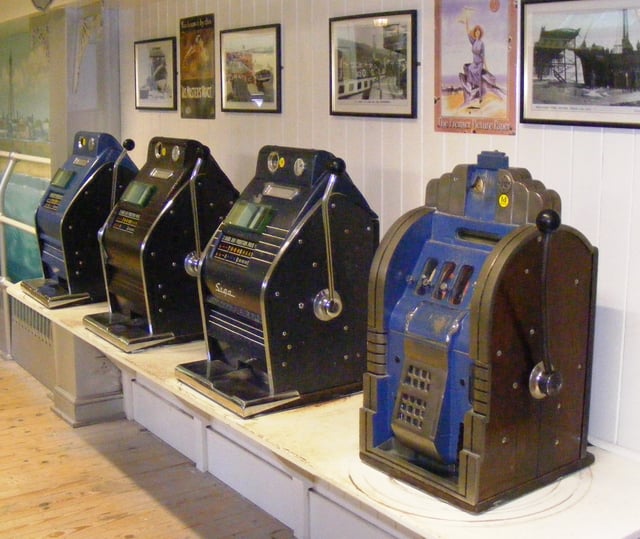
The Diamond 3 Star, a model of coin-operated slot machines produced by Sega in the 1950s
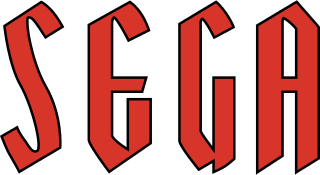
Sega Enterprises, Ltd.'s logo until 1975
In 1940, American businessmen Martin Bromley, Irving Bromberg, and James Humpert formed Standard Games in Honolulu, Hawaii. Their aim was to provide coin-operated amusement machines, including slot machines, to military bases as the increase in personnel with the onset of World War II would create demand for entertainment. After the war, the founders sold Standard Games and established Service Games, named for the military focus. After the United States government outlawed slot machines in its territories in 1951, Bromley sent employees Richard Stewart and Ray LeMaire to Tokyo to establish Service Games of Japan, providing coin-operated slot machines to U.S. bases in Japan.[7][8][9][10] A year later, all five men established Service Games Panama to control the various entities of Service Games worldwide. The company expanded over the next seven years to include distribution in South Korea, the Philippines, and South Vietnam.[11]The%20Sega%20Arcade%20Revolution%2C]]The name Sega, an abbreviation of Service Games,[[12]](https://openlibrary.org/search?q=Kent%2C%20Steven%20L.%20%282001%29.%20 [[CITE|12|https://openlibrary.org/search?q=Kent%2C%20Steven%20L.%20%282001%29.%20*The%20Ultimate%20History%20of%20V)[11]
Due to notoriety received from investigations into criminal business practices, Service Games of Japan was dissolved on May 31, 1960.[11] On June 3,[13] Bromley established two companies to take over its business activities, Nihon Goraku Bussan and Nihon Kikai Seizō.[4] The two new companies purchased all of Service Games of Japan's assets. Kikai Seizō, doing business as Sega, Inc., focused on manufacturing slot machines. Goraku Bussan, doing business under Stewart as Utamatic, Inc., served as a distributor and operator of coin-operated machines, particularly jukeboxes.[11][14][15] The companies merged in 1964, retaining the Nihon Goraku Bussan name.[11]
David Rosen, an American officer in the United States Air Force stationed in Japan, launched a photo booth business in Tokyo in 1954.[7] This company became Rosen Enterprises, and in 1957 began importing coin-operated games to Japan. In 1965, Nihon Goraku Bussan acquired Rosen Enterprises to form Sega Enterprises, Ltd.[5] Rosen was installed as the CEO and managing director, while Stewart was named president and LeMaire was the director of planning. Shortly afterward, Sega stopped leasing to military bases and moved its focus from slot machines to coin-operated amusement machines.[16] Its imports included Rock-Ola jukeboxes, pinball games by Williams, and gun games by Midway Manufacturing.[17]
Because Sega imported second-hand machines that required frequent maintenance, it began constructing replacement guns and flippers for its imported games.
This began the company's transition from importer to manufacturer.
According to former Sega director Akira Nagai, this led to the company developing their own games.[17] The first electromechanical game Sega manufactured was the submarine simulator Periscope, released worldwide in the late 1960s. It featured light and sound effects considered innovative, and was successful in Japan. It was exported to malls and department stores in Europe and the United States, and helped standardize the 25-cent-per-play cost for arcade games in the U.S. Sega was surprised by the success, and for the next two years the company produced and exported between eight and ten games per year.[18] Despite this, rampant piracy in the industry would lead to Sega stepping away from exporting its games around 1970.[19]
In 1969, Sega was sold to American conglomerate Gulf and Western Industries, although Rosen remained CEO. In 1974, Gulf and Western made Sega Enterprises, Ltd. a subsidiary of an American company renamed Sega Enterprises, Inc. Sega released Pong-Tron, its first video-based game, in 1973.[19] Despite late competition from Taito's hit arcade game Space Invaders in 1978,[17] Sega prospered from the arcade game boom of the late 1970s, with revenues climbing to over US$ 100 million by 1979. During this period, Sega acquired Gremlin Industries, which manufactured microprocessor-based arcade games,[20] and Esco Boueki, a coin-op distributor founded and owned by Hayao Nakayama. Nakayama was placed in charge of Sega's Japanese operations.[21] In the early 1980s, Sega was one of the top five arcade game manufacturers active in the United States, as company revenues rose to $214 million.[22] 1979 saw the release of Head On Namco]] later used in [23] In 1981, Sega licensed and released Frogger, its most successful game until then.[24] In 1982, Sega introduced the first game with isometric graphics, Zaxxon.[25]
Entry into the game console market (1982–1989)
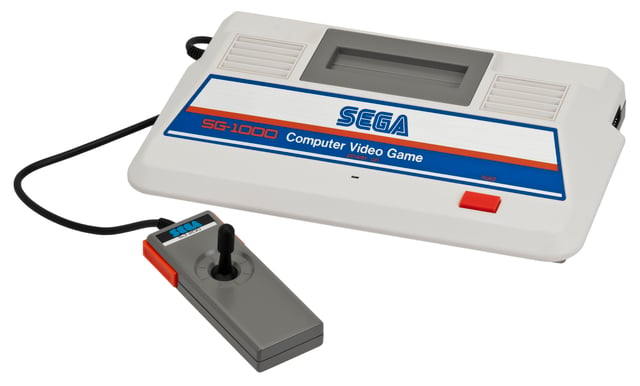
Sega's first video game console, the SG-1000
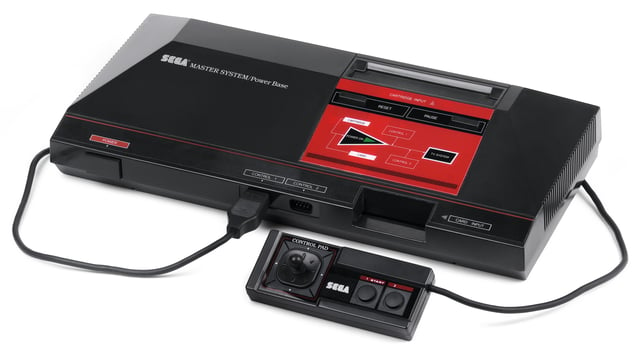
The Master System, released in North America in 1986 and Europe in 1987
Following a downturn in the arcade business starting in 1982, Gulf and Western sold its North American arcade game manufacturing organization and the licensing rights for its arcade games to Bally Manufacturing.[26][27] Gulf and Western retained Sega's North American R&D operation and its Japanese subsidiary, Sega Enterprises, Ltd. With its arcade business in decline, Sega Enterprises, Ltd. president Nakayama advocated for the company to use its hardware expertise to move into the home consumer market in Japan.[28] This led to Sega's development of a computer, the SC-3000. Learning that Nintendo was developing a games-only console, the Famicom, Sega developed its first home video game system, the SG-1000, alongside the SC-3000.[29] Rebranded versions of the SG-1000 were released in several other markets worldwide.[29][30][31][29] Due in part to the SG-1000's steadier stream of releases, coupled with a recall on Famicom units by Nintendo, the SG-1000 sold 160,000 units in 1983, which far exceeded Sega's projection of 50,000 in the first year.[29] However, by 1984 the Famicom began to outpace the SG-1000. This was in part because Nintendo expanded its game library by courting third-party developers, whereas Sega was hesitant to collaborate with companies with which they were competing in the arcades.[29]
Shortly after the launch of the SG-1000, and the death of company founder Charles Bludhorn, Gulf and Western began to sell off its secondary businesses.[27] Nakayama and Rosen arranged a management buyout of the Japanese subsidiary in 1984 with financial backing from CSK Corporation, a prominent Japanese software company.[34] Sega's Japanese assets were purchased for $38 million by a group of investors led by Rosen and Nakayama. Isao Okawa, head of CSK, became chairman,[21] while Nakayama was installed as CEO of Sega Enterprises, Ltd.[35]
In 1985, Sega began working on the Mark III,[29] a redesigned SG-1000.[37] For North America, Sega rebranded the Mark III as the Master System,[38] with a futuristic design intended to appeal to Western tastes.[39] The Mark III was released in Japan in October 1985 at a price of ¥15,000.[40] Despite featuring more powerful hardware than the Famicom, it was unsuccessful at launch. As Nintendo required third-party developers not to publish their Famicom games on other consoles, Sega developed its own games and obtained the rights to port games from other developers.[29] Sales of the Master System in the United States were handicapped by ineffective marketing by Tonka, an American toy company who marketed the console there on Sega's behalf.[41] By early 1992, production had ceased in North America. The Master System sold between 1.5 million and 2 million units in the region.[27] This was less market share in North America than both Nintendo and Atari, which controlled 80 percent and 12 percent of the market respectively.[43] However, the Master System was eventually a success in Europe, where it outsold the NES by a considerable margin.[44][45] As late as 1993, the Master System's active installed user base in Europe was 6.25 million units.[44] The Master System has had continued success in Brazil. New versions continue to be released by Sega's partner in the region, Tectoy.[46] By 2016, the Master System had sold 8 million units in Brazil.[47] Its continuing success since its release in the region in September 1989 makes the Master System the longest-lived console in history.[48][49]
During 1984, Sega opened its European division of arcade distribution, Sega Europe.[50] It re-entered the North American arcade market in 1985 with the establishment of Sega Enterprises USA at the end of a deal with Bally.
The release of Hang-On in 1985 would prove successful in the region, becoming so popular that Sega struggled to keep up with demand for the game.[51] UFO Catcher was introduced in 1985 and as of 2005 was Japan's most commonly installed claw crane game.[52] In 1986, Sega of America was established to manage the company's consumer products in North America.[53] Out Run, released in 1986, became Sega's best selling arcade cabinet of the 1980s.[29] Former Sega director Akira Nagai has stated that Hang-On and Out Run helped to pull the arcade game market out of the 1982 downturn and created new genres of video games.[17]
Genesis, Sonic the Hedgehog, and mainstream success (1989–1994)
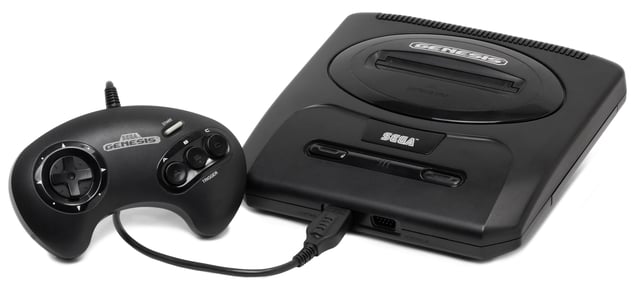
The Sega Genesis (second North American version pictured) took control of the 16-bit console market.
With the arcade game market once again growing, Sega was one of the most recognized game brands at the end of the 1980s.
In the arcades, the company focused on releasing games to appeal to diverse tastes, including racing games and side-scrollers.[55] For its home console business, Sega released the Master System's successor, the Mega Drive, in Japan on October 29, 1988. However, the Mega Drive's launch was overshadowed by Nintendo's release of Super Mario Bros. 3 a week earlier. Positive coverage from magazines Famitsu and Beep! helped establish a following, but Sega only shipped 400,000 units in the first year.[56] The Mega Drive struggled to compete against the Famicom[57] and lagged behind Nintendo's Super Famicom and NEC's PC Engine in Japanese sales throughout the 16-bit era.[58] For the North American launch, where the console was renamed Genesis, Sega had no sales and marketing organization in the region. After Atari declined an offer to market the console in the region, Sega launched the console through its own Sega of America subsidiary. Genesis was launched in New York City and Los Angeles on August 14, 1989, and in the rest of North America later that year.[59] The European version of the Mega Drive was released in September 1990.[60]
Former Atari executive and new Sega of America CEO Michael Katz developed a two-part strategy to build sales in North America.
The first part involved a marketing campaign to challenge Nintendo and emphasize the more arcade-like experience available on the Genesis,[59][61] with slogans including "Genesis does what Nintendon't".[56] Since Nintendo owned the console rights to most arcade games of the time, the second part involved creating a library of recognizable games which used the names and likenesses of celebrities and athletes, such as Michael Jackson's Moonwalker and Joe Montana Football.[7][62] Nonetheless, Sega had difficulty overcoming Nintendo's ubiquity in homes.[63] Despite being tasked by Nakayama to sell one million units in the first year, Katz and Sega of America sold only 500,000.[56]
As Alex Kidd, Sega's mascot during the late 1980s, had failed to catch on with the public, Sega sought a new flagship series to compete with Nintendo's Mario series.[64] Artist Naoto Ohshima proposed a hedgehog with red shoes he called "Mr. Needlemouse".[65] This character was renamed Sonic the Hedgehog, and went on to feature in one of the best-selling video game franchises in history.[65]Console%20Wars%3A%20Sega%2C%20Nintend]][66] The Sonic the Hedgehog tech demo ted by Yuji Naka, who had developed an algorithm that allowed a sprite to move smoothly on a curve. Naka's prototype was a platform game that involved a fast-moving character rolling in a ball through a winding tube; this was fleshed out with Ohshima's character design and levels conceived by designer Hirokazu Yasuhara.[67] Sonic's color was chosen to match Sega's cobalt blue logo. His shoes were inspired by Michael Jackson's boots, and his personality by Bill Clinton's "can-do" attitude.[68][69][70]
Nakayama hired Tom Kalinske to replace Katz as CEO of Sega of America in mid-1990. Although Kalinske knew little about the video game market, he surrounded himself with industry-savvy advisors. A believer in the razor-and-blades business model, he developed a four-point plan: cut the price of the Genesis, create a U.S.-based team to develop games targeted at the American market, expand the aggressive advertising campaigns, and replace the bundled game Altered Beast with Sonic the Hedgehog. The Japanese board of directors disapproved,[63] but it was approved by Nakayama, who told Kalinske, "I hired you to make the decisions for Europe and the Americas, so go ahead and do it."[56] In large part due to the popularity of Sonic the Hedgehog,[63] the Genesis outsold its main competitor, the Super Nintendo Entertainment System, in the United States nearly two to one during the 1991 holiday season. By January 1992, Sega controlled 65 percent of the 16-bit console market, making it the first time Nintendo was not the console leader since 1985.[71] Sega outsold Nintendo for four consecutive Christmas seasons[72] due to the Genesis' head start, lower price, and a larger library compared to the Super Nintendo at release.[73]
In 1990, Sega launched the Game Gear, a handheld console, to compete against Nintendo's Game Boy. The Game Gear was designed as a portable version of the Master System and featured a full-color screen, in contrast to the monochrome Game Boy screen.[74] However, due to its short battery life, lack of original games, and weak support from Sega, the Game Gear did not surpass the Game Boy, having sold approximately 11 million units.[75] Sega launched the Mega-CD in Japan on December 1, 1991, initially retailing at JP¥ 49,800.[76] The add-on used CD-ROM technology, which could hold 640 times more data than the ROM cartridges of Genesis games. Further features include a second, faster processor, vastly expanded system memory, a graphics chip that performed scaling and rotation similar to Sega's arcade games, and an additional sound chip.[77][78] In North America, it was renamed the Sega CD and launched on October 15, 1992, with a retail price of US$ 299.[77] It was released in Europe as the Mega-CD in 1993.[76] The Mega-CD sold only 100,000 units during its first year in Japan, falling well below expectations.[76] However, Sega had success with arcade games; in 1992 and 1993, the new Sega Model 1 arcade system board showcased in-house development studio Sega AM2's Virtua Racing and Virtua Fighter (the first 3D fighting game), which played a crucial role in popularizing 3D polygonal graphics.[79][80][81]
32X, Saturn, and falling sales (1994–1999)
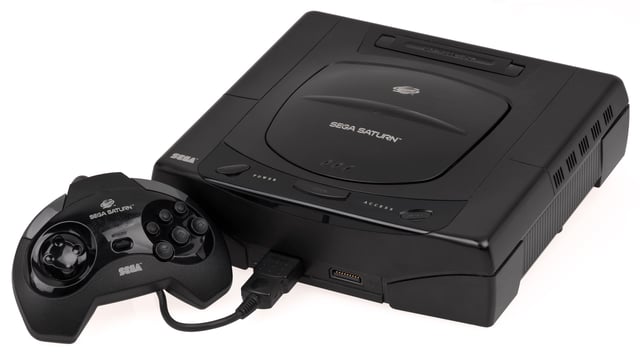
The Sega Saturn was not as successful as its predecessor, the Genesis.
Sega began work on the Genesis' successor, the Sega Saturn, over two years before the system was showcased at the Tokyo Toy Show in June 1994.[82] According to former Sega of America producer Scot Bayless, Nakayama became concerned about the 1994 release of the Atari Jaguar, and that the Saturn would not be available until the next year. As a result, Nakayama decided to have a second console release to market by the end of 1994. Sega began to develop the 32X, a Genesis add-on which would serve as a less expensive entry into the 32-bit era.[83] The 32X would not be compatible with the Saturn, but would play Genesis games.[35] Sega released the 32X on November 21, 1994 in North America, December 3, 1994 in Japan, and January 1995 in PAL territories, and was sold at less than half of the Saturn's launch price.[84][85] After the holiday season, however, interest in the 32X rapidly declined.[83][86]
Sega released the Saturn in Japan on November 22, 1994, at ¥ 44,800.[87] Virtua Fighter, a port of the popular arcade game, sold at a nearly one-to-one ratio with the Saturn at launch and was crucial to the system's early success in Japan.[88][89][90] Sega's initial shipment of 200,000 Saturn units sold out on the first day,[7][90][91] and it was more popular than new competitor Sony's PlayStation in Japan.[90][92] In March 1995, Sega of America CEO Tom Kalinske announced that the Saturn would be released in the U.S. on "Saturnday" (Saturday) September 2, 1995.[93][94] However, Sega of Japan mandated an early launch to give the Saturn an advantage over the PlayStation.[91] At the first Electronic Entertainment Expo (E3) in Los Angeles on May 11, 1995, Kalinske revealed the release price of US$ 399 (including a copy of Virtua Fighter [95]) and revealed that Sega had shipped 30,000 Saturns to Toys "R" Us, Babbage's, Electronics Boutique, and Software Etc. for immediate release.[93] The Saturn's release in Europe also came before the previously announced North American date, on July 8, 1995, at a price of ₤ 399.99.[96] Within two days of the PlayStation's American launch on September 9, 1995, the PlayStation sold more units than the Saturn had in the five months following its surprise launch.[97][98] Within its first year, the PlayStation secured over 20 percent of the U.S. video game market.[99] Sega also underestimated the continued popularity of the Genesis; sales of 16-bit games and consoles accounted for 64 percent of the market in 1995.[100][101] Despite capturing 43 percent of the dollar share of the U.S. market and selling more than 2 million Genesis units in 1995, Kalinske estimated that Sega could have sold another 300,000 consoles if they had been prepared for demand.[102]
Sega announced that Shoichiro Irimajiri had been appointed chairman and CEO of Sega of America in July 1996, while Kalinske left Sega after September 30 of that year.[103][104] A former Honda executive,[105][106] Irimajiri had been involved with Sega of America since joining Sega in 1993.[103][107] The company also announced that Rosen and Nakayama had resigned from their positions at Sega of America, though both remained with Sega.[103][108] Bernie Stolar, a former executive at Sony Computer Entertainment of America,[109][110] became Sega of America's executive vice president in charge of product development and third-party relations.[103][104] Stolar was not supportive of the Saturn, believing its hardware was poorly designed.[7] While Stolar had stated that "the Saturn is not our future" at E3 1997, he continued to emphasize the quality of its games,[7] and later reflected that "we tried to wind it down as cleanly as we could for the consumer".[110] At Sony, Stolar had opposed the localization of certain Japanese PlayStation games that he felt would not represent the system well in North America. He advocated a similar policy for the Saturn, although he later sought to distance himself from this stance.[7][111][112] Other changes included a softer image in Sega's advertising, including removing the "Sega!" scream, and holding press events for the education industry.[113]
Sega partnered with GE to develop the Model 2 arcade system board, building onto 3D technology in the arcade industry at the time. This led to several successful arcade titles, including Daytona USA*]], launched in a limited capacity in late 1993 and worldwide in 1994. Other popular games included* Virtua Cop and Virtua Fighter 2.[114] The Model 2 was equipped with better hardware than any home video game consoles at the time.[115] Aside from the Saturn, Sega made forays in the PC market with the 1995 establishment of SegaSoft, which was tasked with creating original Saturn and PC games.[116]Electronic%20Gaming%20Month]][[117]](https://openlibrary.org/search?q=%22Trailing%20Sony%2C%20Sega%20Restructures%22.%20 [[CITE|117|https://openlibrary.org/search?q=%22Trailing%20Sony%2C%20Sega%20Restructures%22.%20GamePro.%20No.)Joypolis Sega World the UK and Australia.[118][119] From 1994 to 1999, Sega participated in the pinball market when it took over Data East's pinball division.[120]
In January 1997, Sega announced their intentions to merge with the Japanese toymaker Bandai. The merger, planned as a $1 billion stock swap whereby Sega would wholly acquire Bandai, was set to form a company known as Sega Bandai, Ltd.[121][122] Though it was to be finalized in October of that year, it was called off in May after growing opposition from Bandai's midlevel executives. Bandai instead agreed to a business alliance with Sega.[123] As a result of Sega's deteriorating financial situation, Nakayama resigned as Sega president in January 1998 in favor of Irimajiri.[105] Nakayama's resignation may have in part been due to the failure of the merger, as well as Sega's 1997 performance.[125] Stolar became CEO and president of Sega of America.[110][126]
The Saturn failed to take the lead in the market.
After the launch of the Nintendo 64 in 1996, sales of the Saturn and its games fell sharply,[110] while the PlayStation outsold the Saturn three-to-one in the U.S. in 1997.[99] Following five years of declining profits,[127] in the fiscal year ending March 31, 1998, Sega suffered its first financial losses since its 1988 listing on the Tokyo Stock Exchange as both a parent company and a corporation as a whole.[128] Shortly before the announcement of the losses, Sega discontinued the Saturn in North America to prepare for the launch of its successor, the Dreamcast.[105][110] The decision effectively left the Western market without Sega games for over one year.[129] The Saturn lasted longer in Japan and Europe,[106] with Irimajiri telling Japanese newspaper Daily Yomiuri that Saturn development would stop at the end of 1998, with games continuing to be produced until the middle of 1999.[130] Sega suffered an additional ¥42.881 billion consolidated net loss in the fiscal year ending March 1999, and announced plans to eliminate 1,000 jobs, nearly a quarter of its workforce.[131][132] With lifetime sales of 9.26 million units,[133] the Saturn is considered a commercial failure,[134] although its 5.75 million units sold in Japan surpassed the Nintendo 64's 5.54 million.[135][136] Sega's arcade divisions also struggled in the late 1990s, partly due to a market slump following competition from home consoles.[137]
Dreamcast and continuing struggles (1998–2001)
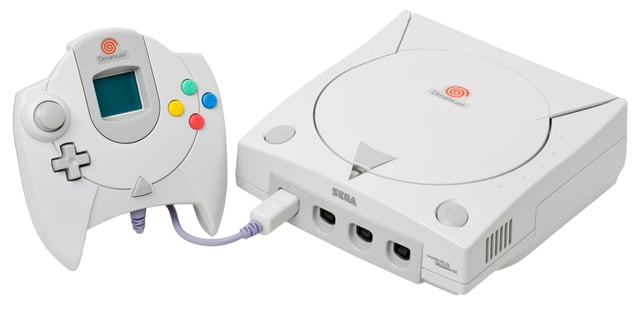
The Dreamcast, discontinued in 2001, was Sega's last video game console.
Despite a 75 percent drop in half-year profits just before the Japanese launch of the Dreamcast, Sega felt confident about its new system.
The Dreamcast attracted significant interest and drew many pre-orders.[138] Sega announced that Sonic Adventure, the next game starring company mascot Sonic the Hedgehog, would be a Dreamcast launch title. The company promoted the game with a large-scale public demonstration at the Tokyo Kokusai Forum Hall.[139][140]Electron]][[141]](https://openlibrary.org/search?q=%22News%3A%20Sonic's%20Back!%22.%20 [[CITE|141|https://openlibrary.org/search?q=%22News%3A%20Sonic's%20Back!%22.%20Sega%20Saturn%20Magazine.%20Vol) shortage of PowerVR chipsets caused by a high failure rate in the manufacturing process.[138][142] As more than half of its limited stock had been pre-ordered, Sega stopped pre-orders in Japan.[143] Before the launch of the Dreamcast in Japan, Sega announced the release of its New Arcade Operation Machine Idea (NAOMI) arcade system board, which served as a cheaper alternative to the Sega Model 3.[144] NAOMI shared the same technology as the Dreamcast, allowing nearly identical ports of arcade games.[129][146]
The Dreamcast launched in Japan on November 27, 1998 at a price of JP¥29,000.
The entire stock of 150,000 consoles sold out by the end of the day.[143] Irimajiri estimated that an additional 200,000 to 300,000 Dreamcast units could have been sold with sufficient supply.[143] He hoped to sell over 1 million Dreamcast units in Japan by February 1999, but less than 900,000 were sold. The low sales undermined Sega's attempts to build up a sufficient installed base to ensure the Dreamcast's survival after the arrival of competition from other manufacturers.[147] Prior to the Western launch, Sega reduced the price of the Dreamcast to JP¥19,900, effectively making the hardware unprofitable but increasing sales.[138]
On August 11, 1999, Sega of America confirmed that Stolar had been fired.[148] Peter Moore, whom Stolar had hired as a Sega of America executive only six months before,[149] was placed in charge of the North American launch.[150][151][152][148] The Dreamcast launched in North America on September 9, 1999 at a price of $199, which Sega dubbed "9/9/99 for $199".[129][147][154] Eighteen games were available on launch in the U.S.[154][155][156] Sega set a record by selling more than 225,132 Dreamcast units in 24 hours, earning $98.4 million in what Moore called "the biggest 24 hours in entertainment retail history".[157] Within two weeks, U.S. Dreamcast sales exceeded 500,000.[157] By Christmas, Sega held 31 percent of the U.S. video game market by revenue.[158] On November 4, Sega announced it had sold over one million Dreamcast units.[159] Nevertheless, the launch was marred by a glitch at one of Sega's manufacturing plants, which produced defective GD-ROMs where data was not properly burned onto the disc.[160] Sega released the Dreamcast in Europe on October 14, 1999,[159] at £200.[138] While Sega sold 500,000 units in Europe by Christmas 1999,[138] sales did not continue at this pace. By October 2000, Sega had sold only about 1 million units in Europe.[161]
Though the Dreamcast's launch had been successful, Sony's PlayStation still held 60 percent of the overall market share in North America at the end of 1999.[159] On March 2, 1999, in what one report called a "highly publicized, vaporware-like announcement",[162] Sony revealed the first details of its "next generation PlayStation".[163][164] The same year, Nintendo announced that its next generation console would meet or exceed anything on the market, and Microsoft began development of its own console, the Xbox.[165][166][167] Sega's initial momentum proved fleeting as U.S. Dreamcast sales—which exceeded 1.5 million by the end of 1999[168]—began to decline as early as January 2000.[169] Poor Japanese sales contributed to Sega's ¥42.88 billion ($404 million) consolidated net loss in the fiscal year ending March 2000. This followed a similar loss of ¥42.881 billion the previous year and marked Sega's third consecutive annual loss.[131][171] Sega's overall sales for the term increased 27.4 percent, and Dreamcast sales in North America and Europe greatly exceeded the company's expectations. However, this coincided with a decrease in profitability due to the investments required to launch the Dreamcast in Western markets and poor software sales in Japan.[131] At the same time, increasingly poor market conditions reduced the profitability of Sega's Japanese arcade business, prompting the company to close 246 locations.[131][172]
Moore stated that the Dreamcast would need to sell 5 million units in the U.S. by the end of 2000 to remain a viable platform, but Sega fell short of this goal with some 3 million units sold.[158][173] Moreover, Sega's attempts to spur Dreamcast sales through lower prices and cash rebates caused escalating financial losses.[174] In March 2001, Sega posted a consolidated net loss of ¥51.7 billion ($417.5 million).[175] While the PlayStation 2's October 26 U.S. launch was marred by shortages, this did not benefit the Dreamcast as much as expected, as many disappointed consumers continued to wait for a PS2 or purchased a PSone.[158][176][177] Eventually, Sony and Nintendo held 50 and 35 percent of the U.S. video game market respectively, while Sega held only 15 percent.[138]
Shift to third-party software development (2001–2003)
Okawa replaced Irimajiri as president of Sega on May 22, 2000.[182] Okawa had long advocated that Sega abandon the console business.[183] Others shared this view; Sega co-founder David Rosen had "always felt it was a bit of a folly for them to be limiting their potential to Sega hardware", and Stolar had suggested that Sega should have sold their company to Microsoft.[7][184] In a September 2000 meeting with Sega's Japanese executives and the heads of its major Japanese game studios, Moore and Sega of America executive Charles Bellfield recommended that Sega abandon its console business; the studio heads walked out.[157] Sega announced a change of name from Sega Enterprises, Ltd. to Sega Corporation[6] effective November 1, 2000. Sega stated in a release that this was to display its commitment to network-based entertainment*.* [185]
On January 23, 2001, Nihon Keizai Shimbun reported that Sega would cease production of the Dreamcast and develop software for other platforms.[186] After an initial denial, Sega of Japan released a press release confirming they were considering producing software for the PlayStation 2 and Game Boy Advance as part of their "new management policy".[187] On January 31, 2001, Sega announced the discontinuation of the Dreamcast after March 31 and the restructuring of the company as a "platform-agnostic" third-party developer.[188][189] The decision was Moore's. Sega also announced a Dreamcast price reduction to $99 to eliminate its unsold inventory, estimated at 930,000 units as of April 2001.[190][191] After a further reduction to $79, the Dreamcast was cleared out of stores at $49.95.[192][193] The final manufactured Dreamcast was autographed by the heads of all nine of Sega's first-party game studios, plus the heads of sports game developer Visual Concepts and audio studio Wave Master, and given away with 55 first-party Dreamcast games through a competition organized by GamePro.[194]
Okawa, who had loaned Sega $500 million in 1999, died on March 16, 2001; shortly before his death, he forgave Sega's debts to him and returned his $695 million worth of Sega and CSK stock, helping the company survive the third-party transition.[195][196][197] He held failed talks with Microsoft about a sale or merger with their Xbox division.[198] As part of the restructuring, nearly one third of Sega's Tokyo workforce was laid off in 2001.[199] 2002 was Sega's fifth consecutive fiscal year of net losses.[200] After Okawa's death, Hideki Sato, a 30-year Sega veteran who had worked on Sega's consoles, became company president. Following poor sales in 2002, Sega cut its profit forecast for 2003 by 90 percent, and explored opportunities for mergers. In 2003, Sega began talks with Sammy Corporation–a pachinko and pachislot manufacturing company–and video game company Namco. On February 13, Sega announced that it would merge with Sammy; however, as late as April 17, Sega was still in talks with Namco, which was attempting to overturn the merger. Sega's consideration of Namco's offer upset Sammy executives. However, the day after Sega announced it was no longer planning to merge with Sammy, Namco withdrew its offer.[201] In 2003, Sato and COO Tetsu Kamaya announced they were stepping down, with Sato replaced by Hisao Oguchi, the head of the Sega studio Hitmaker.[202]
After the decline of the global arcade industry around the 21st century, Sega introduced several novel concepts tailored to the Japanese market.
Derby Owners Club was an arcade machine with memory cards for data storage, designed to take over half an hour to complete and costing JP¥500 to play. Testing of Derby Owners Club in an arcade in Chicago showed that it became the most popular machine in the arcade, with a 92% replay rate. While the eight-player Japanese version of the game was released in 1999, due to size issues, the game was reduced to a smaller four player version and released in North America in 2003.[203] Trading card game machines were introduced, with games such as World Club Champion Football for general audiences and Mushiking: The King of Beetles for young children. Sega also introduced internet functionality in arcades with Virtua Fighter 4 in 2001, and further enhanced it with ALL.Net, introduced in 2004.[204]
Sammy takeover and business expansion (2003–2015)

Sega Sammy Holdings (current logo pictured) was founded in 2004 with pachinko and pachislot manufacturer Sammy Corporation's purchase of Sega.
In August 2003, Sammy bought 22.4 percent of Sega's shares from CSK.[205] In the same year, Sammy primary owner Hajime Satomi stated that Sega's activity would focus on their profitable arcade business as opposed to their loss-incurring home software development.[206] In 2004, Sammy completed a takeover by purchasing a controlling share in Sega Corporation for $1.1 billion. Sega Sammy Holdings, an entertainment conglomerate, was created. Sega and Sammy became subsidiaries of Sega Sammy Holdings, with both companies operating independently, while the executive departments merged. According to the first Sega Sammy Annual Report, the merger went ahead as both companies were facing difficulties. Satomi stated that Sega had been operating at a loss for nearly 10 years,[207] while Sammy feared stagnation and overreliance of its highly profitable pachislot and pachinko machine business, and wanted to diversify.[52] Sega Sammy Holdings was structured into four parts: Consumer Business (video games), Amusement Machine Business (arcade games), Amusement Center Business (Sega's theme parks and arcades) and Pachislot and Pachinko Business (Sammy's pachinko and pachislot business).[209]
In the console and handheld business, Sega found success with games targeted at the Japanese market such as the Yakuza and Hatsune Miku: Project DIVA series. In Japan, Sega distributes games from smaller Japanese game developers and localizations of Western games.[210][211] During 2003, Sega had plans of co-operating with John Woo on video games published by his Tiger Hill Entertainment studio,[212] but plans fell through.[213] In amusement arcades, Sega's most successful games, such as Sangokushi Taisen and Border Break, continued to be based on network and card systems. Arcade machine sales incurred higher profits than their console, portable, and PC games on a year-to-year basis until the 2010s.[214] In 2004, the GameWorks chain of arcades came under Sega ownership, until it was sold in 2011. In 2009, Sega Republic, an indoor theme park, opened in Dubai. The next year, Sega began providing the 3D imaging for Hatsune Miku's holographic concerts.[215] In 2013, Index Corporation was purchased by Sega Sammy after going bankrupt.[216] After the buyout, Sega implemented a corporate spin-off with Index, and rebranded its game assets as Atlus, a wholly owned subsidiary of Sega.[217]
Due in part to the decline of packaged game sales worldwide in the 2010s,[218] Sega began layoffs and closed five offices based in Europe and Australia on July 1, 2012.[219] This was to focus on the digital game market, such as PC and mobile devices.[220][221] Sega gradually reduced its arcade centers from 450 in 2005[222] to around 200 in 2015.[223] In the mobile market, Sega released its first app on the iTunes Store with a version of Super Monkey Ball in 2008. The Western lineup consisted of emulations of games and pay-to-play apps, which were eventually overshadowed by more social and free-to-play games, leading to 19 older mobile games being pulled due to quality concerns in May 2015.[224][225] In 2012, Sega also began acquiring studios for mobile development, with studios such as Hardlight, Three Rings Design, and Demiurge Studios becoming fully owned subsidiaries.[226][227][228]
To streamline operations, Sega established operational firms for each of its businesses in the 2010s.
In 2012, Sega established Sega Networks as a subsidiary company for its mobile games.[229] The same year, Sega Entertainment was established for Sega's amusement facility business.[230] In January 2015, Sega of America announced their relocation from San Francisco to Atlus USA's headquarters in Irvine, California, which was completed later that year.[231]
Over the course of the existence of Sega Sammy Holdings to 2015, Sega's operating income generally saw improvements compared to Sega's past financial problems, but was not profitable every year of operation.[232]
| Business year | 2005 | 2006 | 2007 | 2008 | 2009 | 2010 | 2011 | 2012 | 2013 | 2014 | 2015 |
|---|---|---|---|---|---|---|---|---|---|---|---|
| Amusement Machine Sales[232] | 7,423 | 12,176 | 11,682 | 7,152 | 6,890 | 7,094 | 7,317 | 7,415 | 1,902 | -1,264 | -2,356 |
| Amusement Center Operations[232] | 5,472 | 9,244 | 132 | -9,807 | -7,520 | -1,338 | 342 | 355 | 1,194 | 60 | -946 |
| Consumer Business[232] | -8,809 | 9,244 | 1,748 | -5,989 | -941 | 6,332 | 1,969 | -15,182 | -732 | 2,089 | 4033 |
Restructuring (2015–present)
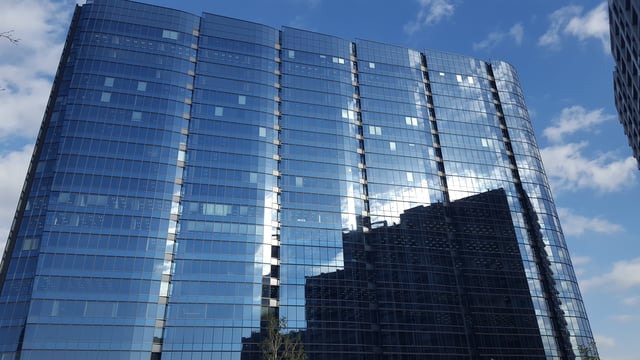
Sega's headquarters in Shinagawa-ku, Tokyo, Japan
In April 2015, Sega Corporation was reorganized into Sega Group, one of three groups of Sega Sammy Holdings.
Sega Holdings Co., Ltd.
was established, with four business sectors under its organization.
Haruki Satomi, son of Hajime Satomi, took office as president and CEO of the company in April 2015.[233][234] Sega Games Co., Ltd. became the legal name of Sega Corporation and continues to manage home video games, while Sega Interactive Co., Ltd. was founded to take control of the arcade division.[235][236] Sega Networks merged with Sega Games Co., Ltd. in 2015.[229] At the Tokyo Game Show in September 2016, Sega announced that they had acquired the intellectual property and development rights to all games developed and published by Technosoft.[237]
Sega Sammy Holdings announced in April 2017 that it would relocate its head office functions and domestic subsidiaries located in the Tokyo metropolitan area to Shinagawa-ku by January 2018. This was to consolidate scattered head office functions including Sega Sammy Holdings, Sammy Corporation, Sega Holdings, Sega Games, Atlus, Sammy Network, and Dartslive.[238] Sega's previous headquarters in Ōta was sold in 2019 and will likely be torn down.[239] Ian Curran, a former executive at THQ and Acclaim Entertainment, replaced John Cheng as president and COO of Sega of America in August 2018.[240]
Following a 70 percent fall in profits for the 2018 fiscal year in comparison to the previous year, despite a 35 percent increase in the sale of console games and success in its PC game business, Sega announced that it would focus on releases for its existing intellectual property instead of new ones. Sega blamed the loss on miscalculations of the market and having too many games under development. Projects in development at Sega include a new game in the Yakuza*]]series,* Persona 5 Scramble: The Phantom Strikers the Sonic the Hedgehog film, and the Sega Genesis Mini.[241] In 2019, Sega acquired Two Point Studios, known for its positively reviewed Two Point Hospital.[242][243]
Corporate structure
Sega's main headquarters is in Shinagawa-ku, Tokyo, Japan.
Additionally, Sega has offices in Irvine, California as Sega of America, and in London as Sega Europe,[244] as well as in Seoul, South Korea as Sega Publishing Korea[245] and in Singapore, Hong Kong, Shanghai, and Taipei.[246] In other regions, Sega has contracted distributors for its games and consoles, such as Tectoy in Brazil.[29] Sega has had offices in France, Germany, Spain, and Australia;[219] those markets have since contracted distributors.[247]
Relations between the different regional offices of Sega have not always been smooth.[248] In the 1990s, some of this conflict may have been caused by Sega president Nakayama and his admiration for Sega of America; according to Kalinske, "There were some guys in the executive suites who really didn't like that Nakayama in particular appeared to favor the U.S. executives.
A lot of the Japanese executives were maybe a little jealous, and I think some of that played into the decisions that were made."[7] By contrast, author Steven L. Kent stated that Nakayama bullied American executives and that Nakayama believed the Japanese executives made the best decisions. He also stated that Kalinske, Stolar, and Moore dreaded meeting with Sega of Japan executives during their times as CEO of Sega of America.[249]
Subsidiaries of Sega Holdings Co., Ltd.
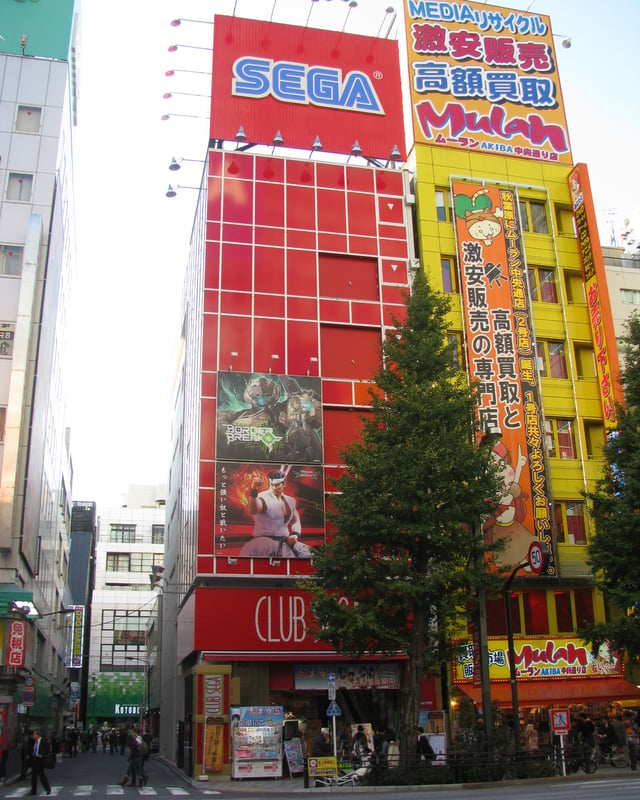
Club Sega game center in Akihabara, Tokyo
After the formation of the Sega Group structure in 2015 and the founding of Sega Holdings, the former Sega Corporation was renamed as Sega Games Co., Ltd.[236] Under this structure, Sega Games is responsible for the home video game market and consumer development.[235] Sega Games also includes Sega Networks, which handles game development for smartphones.[233] Sega currently develops and publishes games for major video game consoles, and has not expressed interest in developing its own consoles again. According to former Sega of Europe CEO Mike Brogan, "There is no future in selling hardware. In any market, through competition, the hardware eventually becomes a commodity... If a company has to sell hardware then it should only be to leverage software, even if that means taking a hit on the hardware."[57]
Sega Interactive Co., Ltd. is the current company responsible for Sega's arcade game business.[235] Sega Toys Co., Ltd. serves as a producer of toys. Sega Toys have created toys for children's franchises such as Oshare Majo: Love and Berry, Mushiking: King of the Beetles, Lilpri, Bakugan*]],* Jewelpet Rilu Rilu Fairilu, Dinosaur King and Hero Bank. Products by Sega Toys released in the West include the Homestar and the iDog. Sega Toys also inherited the Sega Pico handheld system and produced software for the console.[251] Sega has operations of bowling alleys and arcades through its Sega Entertainment Co., Ltd. subsidiary.[235] The company's DartsLive subsidiary is involved with electronic darts games,[246] while Sega Logistics Service is focused on the distribution and repair of arcade games.[235] In 2015, Sega and the Japanese advertising agency Hakuhodo, formed a joint venture called Stories LLC with the purpose of creating branded entertainment for film and TV. Stories LLC has exclusive licensing rights to adapt Sega properties into film and television.[252][253] Properties in production reportedly include Shinobi, Golden Axe, Virtua Fighter, The House of the Dead, and Crazy Taxi.[254][255]
Software research and development
As a games publisher, Sega produces games through its research and development teams.
The Sonic the Hedgehog franchise, maintained through Sega's Sonic Team division, is one of the best-selling franchises in the history of video games.[256] Some games produced by Sega, such as those from Sega Technical Institute from 1991 to 1996, and games produced by Sega's subsidiary companies in the Dreamcast era, have been recognized for their creativity.[129] Sega has also acquired third-party studios that are now owned by the company, including Amplitude Studios,[257] Atlus,[217] Creative Assembly,[258] Demiurge Studios,[226] Hardlight,[228] Relic Entertainment,[259] Sports Interactive,[260] and Two Point Studios.[242][243]
Sega's software research and development teams originated with one development division operating under Sega's longtime head of R&D, Hisashi Suzuki.
As the market increased for home video game consoles, Sega expanded with three Consumer Development (CS) divisions, while after October 1983, arcade development expanded to three teams: Sega DD#1, 2, and 3.
Some time after the release of Power Drift, the company restructured its teams again as the Sega Amusement Machine Research and Development Teams, or AM teams. Each arcade division was segregated, and a rivalry existed between the arcade and consumer development divisions.[261] In what has been called "a brief moment of remarkable creativity",[129] in 2000, Sega restructured its arcade and console development teams into nine semi-autonomous studios headed by the company's top designers.[7][154][263] Studios included United Game Artists, Hitmaker, Smilebit, Overworks, Sega AM2, and Sonic Team.[129] Sega's design houses were encouraged to experiment and benefited from a relatively lax approval process.[264] After taking over as company president in 2003, Hisao Oguchi announced his intention to consolidate Sega's studios.[202] Prior to the acquisition by Sammy, Sega began the process of re-integrating its subsidiaries into the main company.[265]
Sega still operates first-party studios as departments of its research and development division.
Sonic Team exists as Sega's CS2 research and development department,[266] while Sega's CS3 department has developed games such as Phantasy Star Online 2,[267] and Sega Interactive's AM2 department has more recently worked on projects such as smartphone game Soul Reverse Zero.[268] Toshihiro Nagoshi, formerly the head of Amusement Vision, continues to be involved with research and development as Sega's chief creative officer while personally working on the Yakuza series.[269]
Legacy
Sega is the world's most prolific arcade game producer, having developed more than 500 games, 70 franchises, and 20 arcade system boards since 1981.
It has been recognized by Guinness World Records for this achievement.[270] Of Sega's arcade division, Eurogamer's Martin Robinson said, "It's boisterous, broad and with a neat sense of showmanship running through its range. On top of that, it has something that's often evaded its console-dwelling cousin: success."[271]
The Sega Genesis is often ranked among the best consoles in history.[272][273][274] In 2014, USgamer's Jeremy Parish credited it for galvanizing the market by breaking Nintendo's near-monopoly, helping create modern sports game franchises, and popularizing television games in the UK.[275] Kalinske felt Sega had innovated by developing games for an older demographic and pioneering the "street date" concept with the simultaneous North American and European release of Sonic the Hedgehog 2.[276] Sega of America's marketing campaign for the Genesis influenced marketing for later consoles.[277]
Despite its commercial failure, the Saturn is well regarded for its library,[96][278][279] though it has been criticized for a lack of high-profile franchise releases.[7] Edge wrote that "hardened loyalists continue to reminisce about the console that brought forth games like Burning Rangers, Guardian Heroes, Dragon Force and Panzer Dragoon Saga".[280] Sega's management was criticized for its handling of the Saturn.[7][96] According to Greg Sewart of 1UP.com, "the Saturn will go down in history as one of the most troubled, and greatest, systems of all time".[278]
The Dreamcast is remembered for being ahead of its time,[281][282][283] with several concepts that became standard in consoles, such as motion controls and online functionality.[284] Its demise has been connected with transitions in the video game industry. In 1001 Video Games You Must Play Before You Die, Duncan Harris wrote that the Dreamcast's end "signaled the demise of arcade gaming culture... Sega's console gave hope that things were not about to change for the worse and that the tenets of fast fun and bright, attractive graphics were not about to sink into a brown and green bog of realistic war games."[285] Parish contrasted the Dreamcast's diverse library with the "suffocating sense of conservatism" that pervaded the industry in the following decade.[286]
In Eurogamer, Damien McFerran wrote that Sega's decisions in the late 1990s were "a tragic spectacle of overconfidence and woefully misguided business practice".[57] Travis Fahs of IGN noted that since the Sammy takeover Sega had developed fewer games and outsourced to more western studios, and that its arcade operations had been significantly reduced. Nonetheless, he wrote: "Sega was one of the most active, creative, and productive developers the industry has ever known, and nothing that can happen to their name since will change that."[7] In 2015, Sega president Haruki Satomi told Famitsu that, in the previous ten years, Sega had "betrayed" the trust of older fans and that he hoped to re-establish the Sega brand.[287] In his 2018 book The Sega Arcade Revolution, Horowitz connected Sega's decline in the arcades after 1995 with broader industry changes; he argued that its most serious problems came from the loss of its creative talent, particularly Yuji Naka and Yu Suzuki, after the Sammy takeover. However, he noted that "as of this writing, Sega is in its best financial shape of the past two decades. The company has endured."[288]
See also
List of Sega video game consoles
List of Sega video game franchises
Lists of Sega games
Sega Pinball
Sega, S.A. SONIC
